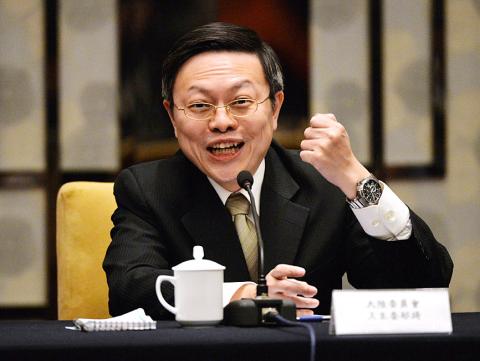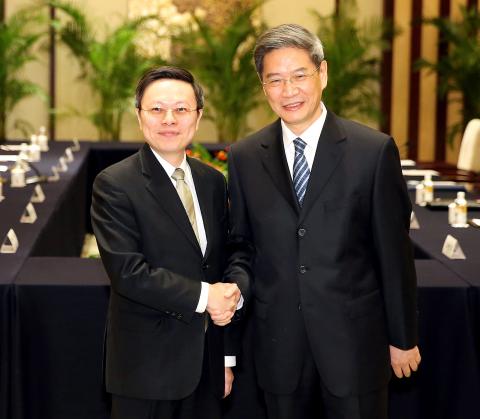Taiwanese and Chinese officials yesterday held the first direct and the highest-level talks since 1949, when the Chinese Nationalist Party (KMT) fled to Taiwan following its defeat by the Chinese Communist Party in the Chinese Civil War.
The historic meeting between Mainland Affairs Council (MAC) Minister Wang Yu-chi (王郁琦) and his counterpart, Taiwan Affairs Office (TAO) Minister Zhang Zhijun (張志軍), in the Chinese city of Nanjing, which agreed to establish a communication channel for future engagement, marked the first time in 65 years that government ministers from across the Taiwan Strait had held talks in their official capacities, despite more than a dozen agreements having been signed during President Ma Ying-jeou’s (馬英九) two terms in office.
Wang, who led a 20-member delegation on a four-day visit to China, told a press conference after a three-hour closed-door meeting at the Purple Palace Nanjing Hotel that his ministry and the TAO had agreed to establish a direct and regular communication platform and reached a consensus in principle on several issues.

Photo: AFP
The communication channel would go hand-in-hand with the current semi-governmental mechanism between the Straits Exchange Foundation (SEF) and the Association of Relations Across the Straits (ARATS), as they are complementary rather than adversarial, Wang said.
The issue of a potential meeting between Ma and Chinese President Xi Jinping (習近平) at an APEC summit in Beijing later this year, which has drawn suspicion from the opposition parties in Taiwan, was not raised at the meeting, nor was the sensitive topic of China’s demarcation of an East China Sea air defense identification zone, Wang said.
The minister said that he had “no regrets” about not discussing the potential Ma-Xi meeting because “it was not on the agenda in the first place.”

Photo: CNA
The Legislative Yuan had put Wang on a tight leash by passing a resolution prohibiting the minister from signing any written document during his visit.
The first highlight of the meeting came before the talks started as hundreds of reporters tried to anticipate how the officials would address each other, a barometer for a breakthrough in bilateral relations.
Wang referred to Zhang as “TAO Minister Zhang Zhijun,” while Zhang simply addressed Wang as “Minister Wang Yu-chi,” leaving out the name of Wang’s ministry, before the two shook hands and made their opening statements.
However, China’s state-owned Xinhua news agency referred to Wang as the “responsible official of Taiwan’s Mainland Affairs Council” in its Chinese-language reports and as “Taiwan’s mainland affairs chief” in its English-language coverage.
Both officials reiterated in their statements that the so-called “1992 consensus” serves as the foundation of bilateral engagement, which would be strengthened under the current framework in the future.
“It’s not been easy for us to be sitting at the same table today,” Wang said.
At the meeting, they agreed to seek a solution on health insurance coverage for Taiwanese students studying in China, pragmatically plan for the establishments of SEF and ARATS offices in each other’s territory and study the feasibility of allowing humanitarian visits to detained nationals once the offices have been established.
Taiwan raised the issue of reciprocal exchange of news information, but did not protest China’s refusal to issue visas to two Taiwanese reporters who wished to travel to cover the visit.
Wang also brought up Taiwan’s hope for parallel progress between economic integration with China and the rest of the world, without receiving a positive response from the Chinese side.
In his opening statement, Zhang said cross-strait relations “cannot afford to suffer from another decline” after they have dramatically improved since May 2008 — when Ma took office.
A Xinhua report said the meeting has reached “positive consensus” on many fronts, including an insistence on the “1992 consensus,” opposition to independence for Taiwan and strengthening exchanges.
The report urged follow-up agreements under the Economic Cooperation Framework Agreement (ECFA) and to study the feasibility of bilateral cooperation on regional economic integration.
Zhang also accepted Wang’s invitation for a return visit, it said.
Wang is scheduled to visit the Sun Yat-sen Mausoleum today, before delivering a speech at Nanjing University on youth exchanges across the Taiwan Strait.
He is due to attend a forum and hold talks with Chinese think tanks tomorrow, before wrapping up the trip and returning to Taipei on Friday.

The US government has signed defense cooperation agreements with Japan and the Philippines to boost the deterrence capabilities of countries in the first island chain, a report by the National Security Bureau (NSB) showed. The main countries on the first island chain include the two nations and Taiwan. The bureau is to present the report at a meeting of the legislature’s Foreign Affairs and National Defense Committee tomorrow. The US military has deployed Typhon missile systems to Japan’s Yamaguchi Prefecture and Zambales province in the Philippines during their joint military exercises. It has also installed NMESIS anti-ship systems in Japan’s Okinawa

‘WIN-WIN’: The Philippines, and central and eastern European countries are important potential drone cooperation partners, Minister of Foreign Affairs Lin Chia-lung said Minister of Foreign Affairs Lin Chia-lung (林佳龍) in an interview published yesterday confirmed that there are joint ventures between Taiwan and Poland in the drone industry. Lin made the remark in an exclusive interview with the Chinese-language Liberty Times (the Taipei Times’ sister paper). The government-backed Taiwan Excellence Drone International Business Opportunities Alliance and the Polish Chamber of Unmanned Systems on Wednesday last week signed a memorandum of understanding in Poland to develop a “non-China” supply chain for drones and work together on key technologies. Asked if Taiwan prioritized Poland among central and eastern European countries in drone collaboration, Lin

TRAGEDY STRIKES TAIPEI: The suspect died after falling off a building after he threw smoke grenades into Taipei Main Station and went on a killing spree in Zhongshan A 27-year-old suspect allegedly threw smoke grenades in Taipei Main Station and then proceeded to Zhongshan MRT Station in a random killing spree that resulted in the death of the suspect and two other civilians, and seven injured, including one in critical condition, as of press time last night. The suspect, identified as a man surnamed Chang Wen (張文), allegedly began the attack at Taipei Main Station, the Taipei Fire Department said, adding that it received a report at 5:24pm that smoke grenades had been thrown in the station. One man in his 50s was rushed to hospital after a cardiac arrest

ON ALERT: Taiwan’s partners would issue warnings if China attempted to use Interpol to target Taiwanese, and the global body has mechanisms to prevent it, an official said China has stationed two to four people specializing in Taiwan affairs at its embassies in several democratic countries to monitor and harass Taiwanese, actions that the host nations would not tolerate, National Security Bureau (NSB) Director-General Tsai Ming-yen (蔡明彥) said yesterday. Tsai made the comments at a meeting of the legislature’s Foreign Affairs and National Defense Committee, which asked him and Minister of National Defense Wellington Koo (顧立雄) to report on potential conflicts in the Taiwan Strait and military preparedness. Democratic Progressive Party (DPP) Legislator Michelle Lin (林楚茵) expressed concern that Beijing has posted personnel from China’s Taiwan Affairs Office to its